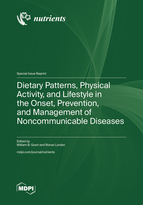Dietary Patterns, Physical Activity, and Lifestyle in the Onset, Prevention, and Management of Noncommunicable Diseases
A special issue of Nutrients (ISSN 2072-6643). This special issue belongs to the section "Nutritional Epidemiology".
Deadline for manuscript submissions: closed (31 August 2022) | Viewed by 44427
Special Issue Editors
Interests: Alzheimer’s disease; cancer; COVID-19; dietary components and patterns; UVB; Vitamin D
Special Issues, Collections and Topics in MDPI journals
Interests: cardiovascular diseases; inflammation; circadian rhythms; dietary supplements; nutraceuticals; aging; exercise; preventative medicine
Special Issues, Collections and Topics in MDPI journals
Special Issue Information
Dear Colleagues,
Noncommunicable diseases are a significant burden on global health systems. According to the World Health Organization, the top ten causes of death globally in 2019 were, in order, ischemic heart disease (9 million deaths/year), stroke (6 million), chronic obstructive pulmonary disease (3 million), lower respiratory tract infections, neonatal conditions, trachea, bronchus, lung cancers, Alzheimer’s disease and other dementias, diarrheal diseases, diabetes mellitus, and kidney diseases. Noncommunicable diseases account for the majority of the deaths worldwide; however, COVID-19 is now also a leading cause of death worldwide.
Decades of research show that dietary and lifestyle factors can contribute to the onset and progression of many noncommunicable diseases. This Special Issue is particularly focused on receiving submissions of research that investigate detrimental dietary patterns, such as the “Western diet” and its major components (added sugar, highly processed food, meat, etc.), or lifestyle factors including air pollution/smoke exposure and low physical activity that contribute to the onset or worsening of chronic noncommunicable diseases and COVID-19. Equally, research that considers approaches that alter diet or lifestyle, which in turn modify pre-existing risk factors to reduce the risk of noncommunicable diseases and COVID-19 are also welcome. Submissions of research involving animal studies, human trials, epidemiological research or metabolomics are encouraged.
Dr. William B. Grant
Dr. Ronan Lordan
Guest Editors
Manuscript Submission Information
Manuscripts should be submitted online at www.mdpi.com by registering and logging in to this website. Once you are registered, click here to go to the submission form. Manuscripts can be submitted until the deadline. All submissions that pass pre-check are peer-reviewed. Accepted papers will be published continuously in the journal (as soon as accepted) and will be listed together on the special issue website. Research articles, review articles as well as short communications are invited. For planned papers, a title and short abstract (about 100 words) can be sent to the Editorial Office for announcement on this website.
Submitted manuscripts should not have been published previously, nor be under consideration for publication elsewhere (except conference proceedings papers). All manuscripts are thoroughly refereed through a single-blind peer-review process. A guide for authors and other relevant information for submission of manuscripts is available on the Instructions for Authors page. Nutrients is an international peer-reviewed open access semimonthly journal published by MDPI.
Please visit the Instructions for Authors page before submitting a manuscript. The Article Processing Charge (APC) for publication in this open access journal is 2900 CHF (Swiss Francs). Submitted papers should be well formatted and use good English. Authors may use MDPI's English editing service prior to publication or during author revisions.
Keywords
- dietary patterns
- lifestyle
- exercise
- cardiovascular diseases
- metabolic syndrome
- obesity
- chronic respiratory diseases
- cancer
- human trials
- epidemiological studies
- human health
- bioactive nutrients
- COVID-19








